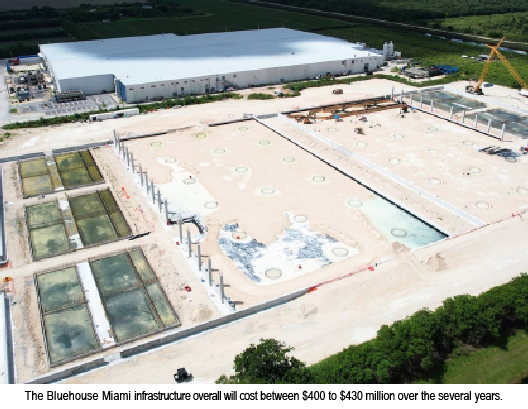United States seafood consumers seeking healthy diets and eco-friendly processing will find a greater supply of farm-raised salmon produced in Miami, Florida from Norway-based Atlantic Sapphire’s (AS) new onshore facility. The Bluehouse Miami salmon farming has a proven technology as a closed-containment recirculating aquaculture system (RAS). This greenhouse for salmon is revolutionizing salmon production to reduce logistics costs but still requires refrigerated trucking to preserve the freshness to foodservice, retail, military/government agencies, and restaurants in the U.S.A.
Norway is known for gravlax, thinly sliced salmon cured with salt, sugar, and dill on pumpernickel bread, and produces half the world’s farmed salmon. Atlantic Sapphire USA ranks the United States as the single largest market in the world for Atlantic salmon at 600,000 metric tons of which 98% is imported from Chile, Canada, and Norway. Demand for salmon increased an average of 9% in the last 7 years and is expected to reach 900,000 metric tons over the next 5 years to 2027. Most U.S. salmon is imported farm-raised either fresh or frozen by air. “Salmon air-freight costs from Norway to the U.S. are around Kr25/kilogram, according to an AS spokesperson in a recent interview.

In general, the annual production of salmon both farm-raised and wild is 3 million metric tons compared to 100 million tons each for poultry and pork. Beef is 60 million tons. The farm-raised wholesale price is higher than meat at $3.00 per pound (55 Norwegian kroner per kilo), as reported in Barron’s, “The Meat Alternative That is Building Scale”.
Global salmon trade patterns underscore the high cost of freight by air, its large carbon footprint, and reduced shelf life. In fact, air transit times from Norway, Faroe Islands, and Iceland to the U.S.A. markets are 3-6 days and are 5-8 days from Latin America (Chile) to the U.S.A. Moreover, the Atlantic Sapphire Miami operation value chain reduces the typical conventional sea-based salmon farming chain from 9 steps from hatchery to consumer to 3 steps which will collapse the costs as well.

The Bluehouse Miami infrastructure overall will cost between $400 to $430 million over several years. The initial investment up to phase 1, was more in the lines of $230 million and that includes infrastructure that can be utilized in both phases 1 & 2. “We started the production cycle of salmon in Miami in November 2018 and the first harvest took place in September of 2020”, said the AS spokesperson. Phase one will reach 10,000 metric tons (22 million pounds per year) once a steady state is achieved, while phase two construction has already commenced in the second half of 2021. The business plan is to reach a production capacity of 220,000 metric tons by 2031 and gradually to 95,000 metric tons in 2026 and complete the build-out of the facility by 2031.
Conventional ocean net-pen farming in open water has issues such as damaging the environment, being costly, and will not meet the forecasted demand to various markets, especially in the U.S. Sea lice and disease management issues are foremost by conventional methods. Platina Seafood, a Norwegian fish company, has sales, import, and distribution from Miami with established cold storage to customers in North America. Platina Seafood is responsible for the distribution of Atlantic Sapphire’s salmon to its North American retailers.
The Miami closed containment system produces salmon from eggs to final products under one roof that simplifying the value chain significantly. The eggs are introduced into the hatcheries and after hatching they are transferred into the first feeding tanks. The hatched eggs are moved to tanks of different sizes and through different cycles of the salmon farming cycle (from freshwater to saltwater). “We have a processing plant on site where we will process and pack the salmon which will be delivered directly to the final markets,” explained the spokesperson for AS. The simplification of the value chain is one of the main logistical advantages of producing salmon in the Bluehouse.
Atlantic Sapphire and Skretting recently announced plans to construct a specialized state-of-the-art feed plant for land-based salmon in Florida to serve Atlantic Sapphire’s US operations with market-leading feed specialized for Bluehouse farming. A local feed plant will minimize the carbon footprint of transporting the feed to the facility, and is expected to cut the Company’s logistics cost, and thereby its cost of production, by approximately USD 0.3/kg HOG.
Another notable attribute of the Miami Bluehouse is it has a unique water source that is naturally purified through limestone rock in a sustainable ancient artesian aquifer. The water is more than 20,000 years old and has never been exposed to man-made contamination such as microplastics. In addition, AS recycles 99 percent of the water.
Distribution of Raised Salmon
Distributing AS locally raised salmon from the Miami operation by refrigerated trucks to any part of the United States has significant advantages in terms of carbon emissions, costs, and freshness of the product. Miami is one of the United States’ largest hubs for salmon trade and the logistics network for the distribution of both fresh and frozen salmon is well developed, according to AS. The combination of the land-based closed containment RAS technology and the temperature-controlled logistics network will extend the shelf-life since there will be fewer days in transit.
Platina Seafood has cold storage sites in Miami, Los Angeles, Boston, and New Jersey. Target markets for the fresh and frozen salmon are throughout the U.S.A. by refrigerated trucks for the Bluehouse Miami farm-raised salmon. The delicious taste, sustainably grown, and eco-friendly Atlantic Sapphire USA salmon will satisfy the appetites of discerning palates from sushi to smoked to Norwegian gravlax cuisines.






